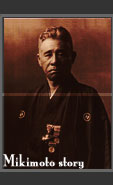Just the
nucleus however, is not enough to get the oyster going about its
work. The technician also inserts a small piece of the mantle tissue
(the mantle is a skin like organ that secretes the mother of pearl).
This piece
of mantle tissue will graft itself onto the surrounding tissues
and then it will produce a man induced pearl sac.
|
|
1.
Freshwater mussels can yield more than one pearl at a time and they
can be reused again.
2. Cages of oysters are lined up in shettered bays for cultivation.
3. Implanting a bead nucleus to jumpstart the oyster's nacre production.
|
The nucleated oysters
are then returned to the sea, where they live in sheltered bays
rich in natural nutrients. The nucleated oysters are suspended from
pearl rafts in order to give them the best conditions for growth.
Pearl technicians constantly monitor the water temperature and feeding
conditions daily at various depths and move the oysters up or down
according to the best growing conditions.
|
| |
|
|
|
|
|
|
| |
A
foreign object having strayed into the oyster between
the shell and the mantle lobe. |
|
|
|
Pearl layers (shell)
Mantle lobe outer epithelium
Mantle lobe inner epithelium |
|
| |
|
|
|
| |
|
|
|
|
| |
The foreign object (nucleus)
being gradually implanted in the mantle lobe. |
|
|
|
| |
|
|
|
|
| |
The nucleus closing up inside
the mantle lobe and the cell in a pearl-sac
secreting nacreous substances |
|
|
|
| |
|
|
|
|
|
|
|
From time to time, the oysters are lifted
out from the sea for cleaning and health treatments. Seaweed, barnacles
and other undersea growths that might impede their feeding are removed
from the shells which are then treated with medicinal compounds
to prevent parasites from hurting the oysters in any way. |
|
1.
Examining and cleaning the oysters from time is necessary to prevent
disease.
2. Bead nucleus of dufferent sizes pearls of corresponding sizes.
Smaller beads pose lesser risk while a bigger one will produce a
larger piece but with a greater risk of oyster mortality.
|
There are nevertheless, many hazardous factors
that cannot be controlled by man. Natural disasters like typhoons,
attacks from predators and even the suffocating red tides
are all fatal to the oysters. However, those oysters that survive
these natural hazards are finally harvested for their pearls.
Every year, millions of oysters are nucleated
but only a fraction of that number survives and even fewer actually
bear a pearl. Of all the oysters that yield a pearl, only a fraction
bear one of gem quality and of these, only a few bear a perfectly
round pearl. Therefore it must be understood that although man may
start the process of pearl production by inserting the irritant
that forms the core of the pearl, nevertheless after this preliminary
interference, everything else is left to the whims of nature. Therefore
even cultured pearls are real jewels. |
|
1. Sieving pearls to
seperate the different sizes.
2 to 3. Assorting pearls by size, shape, colour, and lustre. It may
take as many as 10,000 pearls to yield enough matching pearls make
a single necklace.
|
Like natural pearls, no two cultured pearls
are ever identical. Therefore sorting pearls calls for refined skills
that blend similar looking pearls together so that they match. When
it comes to drilling, a great deal of care and precision is required
as a hole drilled even fractionally oft centre can rum the pearl
for use in a necklace or jewel that depends upon the symmetrical
assembly of its pearls. Because no two cultured pearls are alike,
assorters go through about ten thousand pearls before they find
enough similar to make a single necklace. Therefore cultured pearls
are truly precious and here it is pertinent to point out that all
marine pearls in the market today, be they akoya. South Sea, Tahitian
or mabe, they are all cultured and cultivated on pearl farms. |
|





















